Abstract
This paper presents a new brush seal construction idea. It was shown that it is possible to use bimetallic elements for the construction of the brush seal, which have a thermoregulatory function by relieving a contact area between bristles and a shaft surface reducing frictional heat flux. This should improve the durability of the seal by diminishing the heat load and significantly decreases the temperature of the seal during the startup/ shutdown. This article shows a simplified construction of the concept brush seal as well as numerical and experimental results.
Nomenclature
α bristles lay angle (deg)
𝛿 seal radial interference (mm)
μ coefficient of friction
b bimetal width (mm)
c bimetal strip width (mm)
F normal force (N)
h bimetal thickness (mm)
L bristles length (mm)
n rotational velocity (RPM)
Q heat flux (W)
v sliding velocity (m/s)
1 Introduction
In large gas or steam turbines there can be dozens of potential leakage paths. The seals in those places have a significant impact on the performance and efficiency of the device. Bearing in mind increasing fuel prices and highly stringent emission standards it is reasonable to make every attempt to improve tightness. In the past few decades one of the relatively new solution, in comparison with commonly used labyrinth seals, is brush seal [19].
Research conducted by Ferguson [7] indicates a tenfold decrease in leakage after the installation of brush seals in relation to the classical labyrinth seal with a 0.7 mm gap for the same performance. Reports of Turbo-Care show that replacing conventional labyrinth seals with brush seals can improve the efficiency of a turbine up to 1% [15]. Nowadays the only solution that can compete in tightness with brush seal is spiral-grooved gas face seal [11]. It is a combination of the labyrinth seal and non-contact face seal with the micron level clearance, compared with traditional labyrinth seal leakage can be reduced by over than 99% [18]. However mentioned value became from CFD results only, there are no experimental results confirming that result.
Brush seal consists of thousands of thin bristles fixed on one end in a seal housing and the other end touching the shaft surface. One of the main operational problems associated with brush seals is a very high heat load of bristles ends while starting and shutting down the sealed units. That heat is generated due to friction between the seal and a rotating shaft. Frictional heat is extremely disadvantageous for two reasons: firstly, friction reduces the efficiency of the device, secondly - it might lead to an excessive temperature rise which could result in damage to the seal and consequently to the whole device [4, 6, 14, 17].
1.1 Brief brush seal constructions review
One way to solve the problem of the excessive heat load is the concept of Retractable brush seal [15]. This is a solution from TurboCare combining the brush seal and the labyrinth seal. The idea is to divide the total seal into smaller segments, which might be slightly movable in relation to one another and to the shaft. All segments are mounted on coil springs in order to cause a radial move away from the shaft. When the flow increases through the sealed device, pressure behind the seal rises as well. That pressure pushes the segments and after overcoming the forces from the spring and friction it causes the closure of the seal segments. That solution provides clearance during the startup/ shutdown and required seal during normal work.
The next concept is a hybrid floating brush seal (HFBS)[10]. The seal rotates with the shaft, it is a combination of the brush seal and the face seal. It combines the advantages of both seals, which allows to compensate displacements of the shaft in an axial and radial directions without the risk of damaging the seal. Thermal load has been reduced by distributing the sliding velocity between the rotating shaft and the fixed housing on the two surfaces. The seal is loosely mounted on the shaft so that it can rotate freely. As a result, approximately 50% of the total surface speed falls to the contact surface of the shaft-seal, while the remainder falls to the contact surface of the seal-housing.
Another solution is a shoed brush seal [9], it is a standard brush seal except that it has a very large number of pads mounted on the free ends of the bristles. The main advantage of that solution is the possibility of rotation in both directions. That solution also significantly reduces the heat generated due to friction. Owing to the fact that the pad is inclined at a very small angle in relation to the surface of the shaft, when the shaft rotates a hydrodynamic force is created between the pads and the shaft. As a consequence, the pad begins to float over the shaft surface which reduces the coefficient of friction, thus, diminishes heat generation.
2 Concept of brush seal with thermal protecting bimetalic element
Seal’s temperature depends on the heat load acting on the seal and thermal conditions. Although it is not usually feasible to change the conditions of the heat exchange, is possible to reduce the heat load. Brush seals are generally mounted with some initial interference, therefore, there is always friction between the bristles’ ends and the shaft. Part of the power supplied to the shaft is lost to overcome frictional resistance in the seal. If we assume that all the energy necessary to overcome the frictional resistance is converted into heat, the heat flux generated will equal the power lost to overcome friction and will be described by the equation (1).
The essence of the new brush seal design idea is to replace some bristles with bimetal elements (Figure 1).
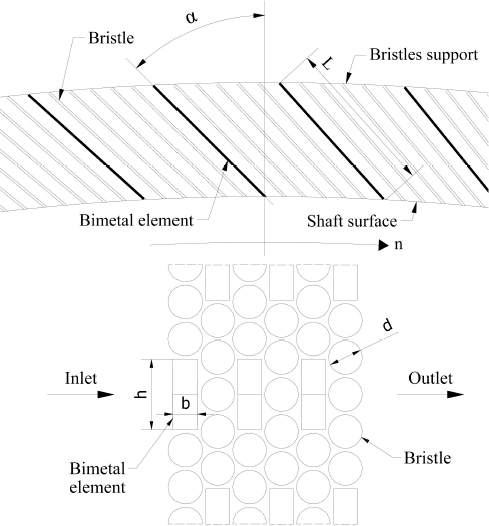
Scheme of the brush seal with bimetal elements
When the permissible temperature level is exceeded the bimetal elements deform in a proper direction, thereby affecting the neighboring bristles causing the decrease in the sealing’s bristles force on the shaft (Figure 2). All bimetal elements should be in the same orientation, otherwise the effect could be reduced.
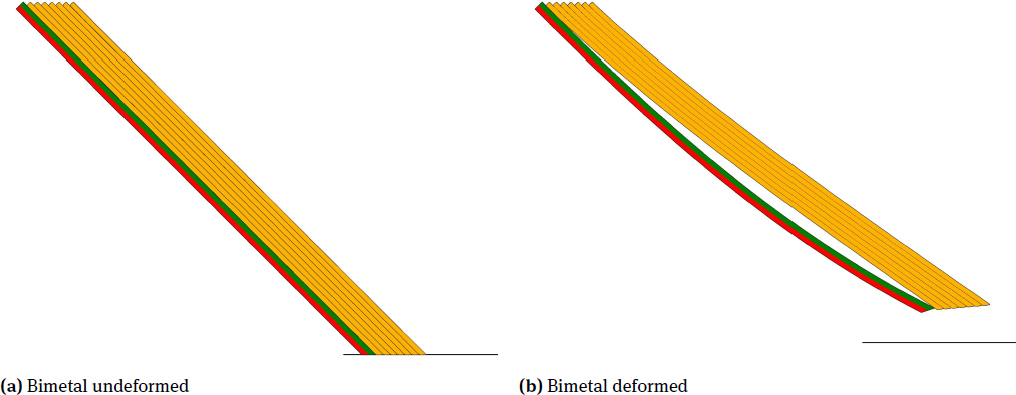
The idea of using bimetal in brush seal
It diminishes the heat flux generated by friction and, thus, the seal temperature decreases. The drop in temperature reduces the deformation of the bimetal elements, the sealing reaches then a new state of equilibrium. Due to the use of bimetal elements, at the stage of a seal design, it is possible to determine the maximum operating temperature. It should be mentioned that the deformation of bimetal in Figure 2b is deliberately increased to better understand the operating principle. In reality without external heat source it is not possible for the gap between the seal and the shaft to exists. It is because to deform bimetal temperature rise is needed, what requires frictional heat whilst to generate this heat frictional force is needed which can not occur without contact between the seal and the shaft.
3 Test rig
In order to validate the effectiveness of the proposed solution an experimental test was performed. For this purpose a simplified concept brush seal segment was created. The construction of the whole brush seal with bimetal elements, as shown in Figure 1, under laboratory conditions is quite a challenge, it requires specialized equipment and technology inaccessible at the university. Hence, instead of a few evenly distributed bimetal elements each pushing some bristles, there is one wide bimetal strip pushing all bristles (Figure 3).
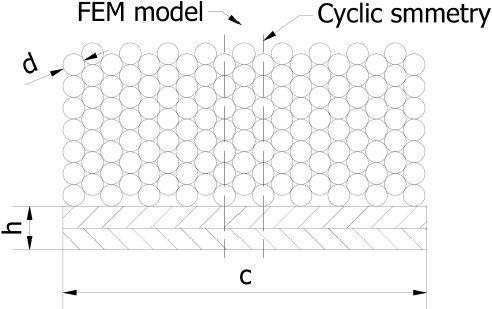
Cross-section of the segment of seal with bimetal element
The dimensions of seal segment are listed in Table 1. The bristles are made of Haynes 25, the most common brush seal alloy, and the bimetal is TB208/110 [1] commonly used as a thermostatic element.
Seal segent dimensions
| Bristles length | L = 15 mm |
| Bristles lay angle | α = 45∘ |
| Bristles diameter | d = 0.1 mm |
| Bristles number | 133 |
| Bimetal dimensions | c × h = 1.9 × 0.2 mm |
The experiment was conducted on a test rig (Figure 4) prepared specially for this purpose. It consisted of: a flow heater (1)which allows to simulate friction heat flux, a laboratory scale (2) with an accuracy of 0.001 N which enables to determine the actual seal segment force, a temperature recorder (3) with a fiber termocouple [8], a micrometer screw (4) with a fixed concept seal segment (5) which allows to set interference with high precision. In order to minimize the effects of high temperature on the accuracy of force measurement there is a glass beaker between the scale and the seal segment.
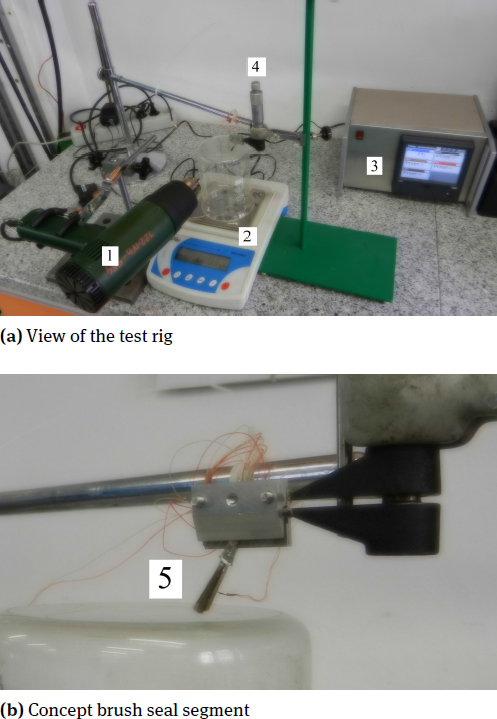
Test rig for determination of force of a concept brush seal with bimetal as a function of interferance and temperature
The experiment was conducted in three steps:
deleting clearance between the seal segment and the glass beaker imitating the shaft surface,
seal segment displacement simulating the radial interference 𝛿r,
heating until the segment force reaches zero.
4 Numerical modelling
To further investigate of the brush seal with a bimetal element and to determine its force characteristic as a function of temperature for different design parameters and operating conditions numerical analysis was performed. The analysed geometry is created by a cantilever bimetal element, a series of 7 cantilever bristles and a shaft surface. Dimensions of the analysed geometry are the same as in experimental seal segment. In order to reduce computional time only 1/9 of segment was analysed with cyclic symmetry boundary condition (Figure 2). Analysed geometry is shown in Figure 5, the initial clearance of 0.05d between the bristles is assumed. The bimetal and bristles are 3D objects whilst the shaft is an analytical rigid surface. The bristles are fixed at one end (Figure 5b), there is frictional contact between bristles each other and bristles’ free ends and the shaft surface (Figure 5c). The model should be loaded with frictional heat flux generated at the bristles-shaft surface contact area. Since the application of a thermal condition to 3D seal geometry is complicated, at the stage of the concept verification, the model is loaded with a linearly increasing uniform temperature.
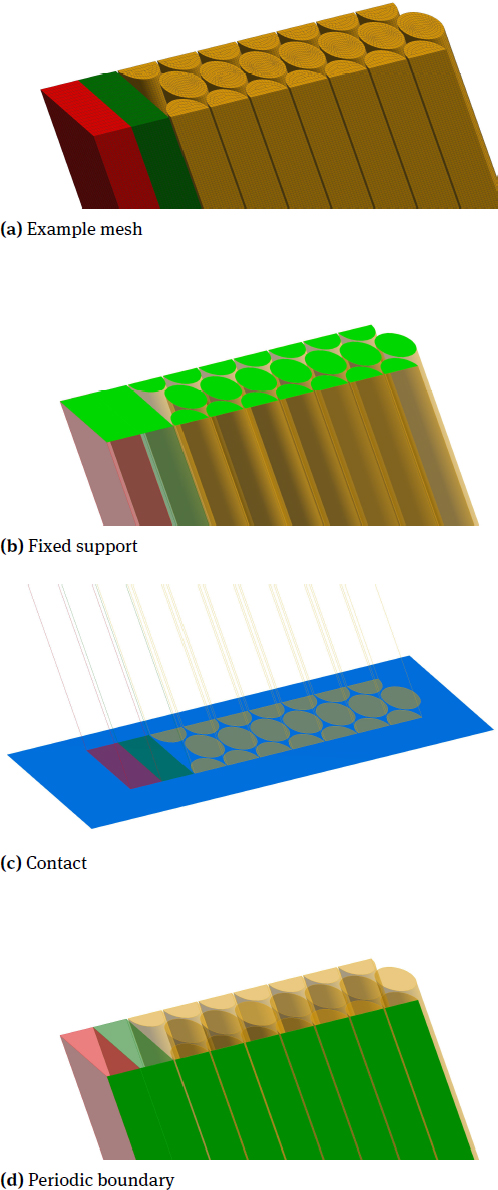
Boundary conditions
Steps of FEM analysis are shown in Figure 6.
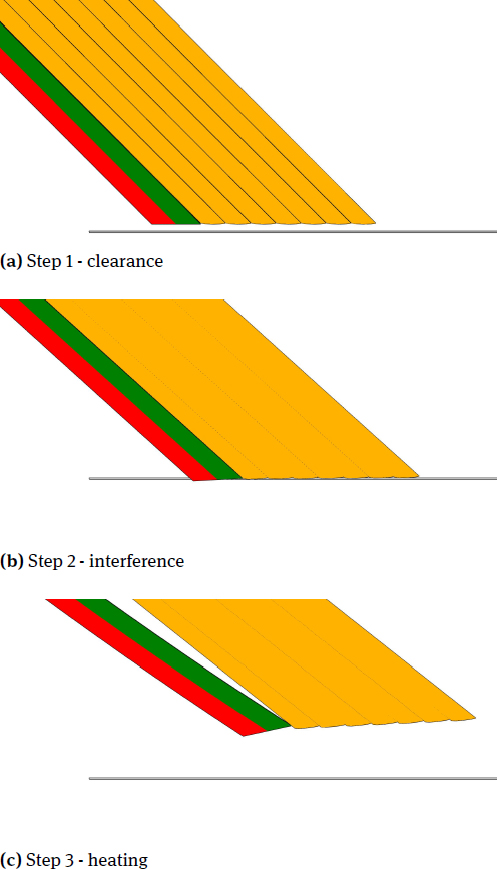
Steps of FEM analysis
seal is mounted with a radial clearance at ambient temperature (Figure 6 a).
displacement of the shaft surface until the deletion of clearance and further displacement of 0.3 mm simulating seal radial interference of 𝛿 = 0.3 mm (Figure 6 b).
uniform temperature load linearly increasing until the segment force reaches zero (Figure 6 c).
Results are shown in Figure 7.
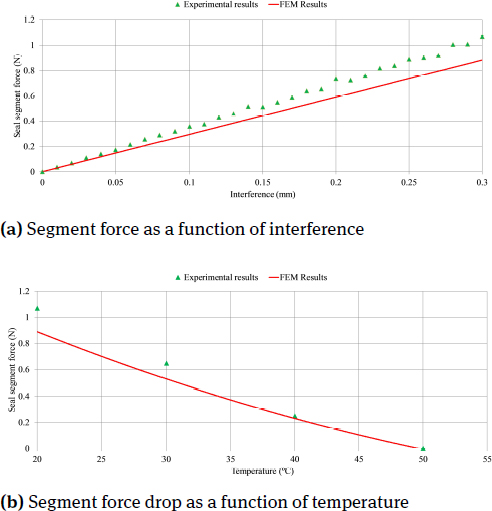
Brush seal with bimetal elements force as a function of interference and temperature
5 Results
As expected, the seal segment force caused by the interference (Figure 7a.) drops with the rising temperature (Figure 7b.) due to the bimetal element interaction. At this configuration force drops to zero at ≈ 50∘C. The force obtained experimentally and numerically is slightly different from each other, in both steps: interference and temperature grow. This is mainly due to geometric differences between the model analysed numerically and the one analysed experimentally. Despite the greatest effort in the assembly of the concept brush seal it was impossible to accurately maintain all dimensions for example: the same length of all wires or constant bristles angle. Average force designation error does not exceed 20 %. Base on that accuracy we can assume that the numerical model sufficiently reflects the behavior of the brush seal with thermoregulation bimetal elements. By an appropriate configuration of: bimetal materials properties and dimensions, bimetal element/bristles ratio we can achieve any thermoregulation characteristic.
6 Influence of different parameters on the termoregulation characteristic
To verify the influence of such design parameters as: bimetal material, initial interference and number of bristles per one bimetal more numerical tests were performed. Each a combination of:
bimetal material : TB60/70 or TB208/110 or TB155/78
initial interference: 0.05; 0.1; 0.15; 0.20; 0.25
bimetal/bristles ratio: 1/3; 1/5; 1/7; 1/9
was checked, altogether sixty different variants. To reduce numbers of charts only few combinations were presented.
6.1 Bimetal/bristle ratio
The influence of the bimetal/ bristles ratio on the seal force characteristic as a function of temperature is shown in Figure 8, the variant with bimetal made of TB60/70 and initial interference of 0.25 mm was chosen.
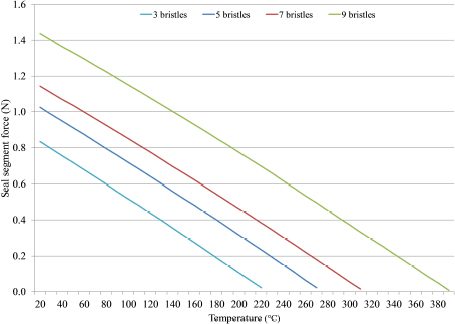
Seal segment force as a function of temperature for various bimetal/bristles ratio
An increasing number of bristles per one bimetal element causes the rise of temperature when the segment force reaches zero. That is because a bigger number of bristles that bimetal pushes requires greater bimetal force which occurs in higher temperature.
6.2 Influence of initial interference
The influence of initial interference on the seal force characteristic as a function of temperature is shown in Figure 9. The variant with bimetal made of TB60/70 and three bristles was chosen.
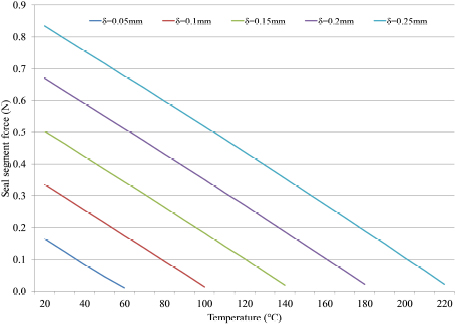
Seal segment force as a function of temperature for various initial interference value
The bigger initial interference we use the higher temperature we need to reach zero force. That is because a bigger interference causes a higher segment reaction force which the bimetal element has to withstand what requires higher temperature.
6.3 Influence of bimetal material
The influence of bimetal material on the seal force characteristic as a function of temperature is shown in Figure 10. The variant with a segment made of bimetal and three bristles and initial interference of 0.25 mm was chosen.
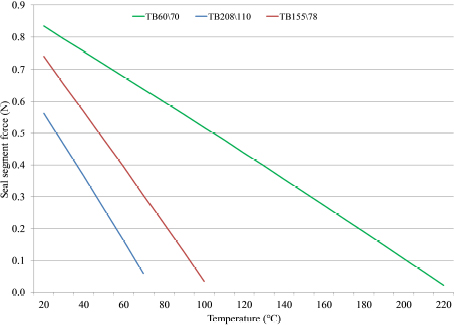
Seal segment force as a function of temperature for various bimetal materials
7 Summary
A new brush seal design which is dedicated to protect the seal against overheating has been presented herein. Construction details have been demonstrated as well as numerical and experimental test results. It has been proven that using bimetal elements in brush seal can reduce bristles tip load, thus, by relieving a contact area between bristles and a shaft surface can significantly reduce frictional heat flux. By proper selection of construction parameters like; bimetal dimensions, material and number of bimetal elements it is possible to build seal with any presupposed maximum operating temperature.
In order to fully verify usefulness of the brush seal with thermal regulating bimetal element further investigation has to be conducted. More complex FEM model including frictional heat should be created to determine equilibrium temperature of the seal. Also the leakage characteristic of the brush seal made according to presented idea needs to be determined. Because flow through seal has a big impact on its stiffness and deflection [2, 5, 13, 16], and thus on frictional heat, for example common brush seal phenomenons like "lift off" [3] and "blow down" [12] can occur, a Fluid Structure Interaction model should be developed to fully investigate the influence of the bimetal elements on the brush seal thermal characteristic.
References
[1] Auerhammer Metallwerk bimetal data sheet.Search in Google Scholar
[2] Rahul A Bidkar, Xiaoqing Zheng, Mehmet Demiroglu, and Norman Turnquist. Stiffness measurement for pressure-loaded brush seals. In ASME 2011 Turbo Expo: Turbine Technical Conference and Exposition pages 789–796. American Society of Mechanical Engineers, 2011.10.1115/GT2011-45399Search in Google Scholar
[3] JW Chew and C Guardino. Simulation of flow and heat transfer in the tip region of a brush seal. International journal of heat and fluid flow, 25(4):649–658, 2004.10.1016/j.ijheatfluidflow.2003.12.001Search in Google Scholar
[4] Mehmet Demiroglu and John A Tichy. An investigation of heat generation characteristics of brush seals. In ASME Turbo Expo 2007: Power for Land, Sea, and Air pages 1261–1270. American Society of Mechanical Engineers, 2007.10.1115/GT2007-28043Search in Google Scholar
[5] Y. Dogu, A.S. Bahar, M.C. Sertcakan, A. Piskin, E. Arican, and M. Kocagul. Computational fluid dynamics investigation of brush seal leakage performance depending on geometric dimensions and operating conditions. Journal of Engineering for Gas Turbines and Power, 138(3), 2016.10.1115/1.4031370Search in Google Scholar
[6] Yahya Dogu and Mahmut F Aksit. Brush seal temperature distribution analysis. Journal of engineering for gas turbines and power, 128(3):599–609, 2006.10.1115/1.2135817Search in Google Scholar
[7] J G Ferguson. Brushes as high performance gas turbine seals. Paper No. ASME 88-GT-182, 1988.10.1115/88-GT-182Search in Google Scholar
[8] Shouqing Huang, Shuangfu Suo, Yongjian Li, Jun Ding, and Yuming Wang. Experimental investigation on fiber thermocouples used in brush seals for temperature measurements. Journal of Engineering for Gas Turbines and Power, 136(9):127–135, 2014.10.1115/1.4027069Search in Google Scholar
[9] J Justak. Hybrid brush seal capable of reverse rotation. proposal to us navy sbir program. In Advanced Turbomachinery Solutions, Stuart, Florida 2000.Search in Google Scholar
[10] SB Lattime, MJ Braun, and FK Choy. Design considerations towards the construction of hybrid floating brush seal (HFBS). Tribology international, 37(2):159–167, 2004.10.1016/S0301-679X(03)00045-8Search in Google Scholar
[11] Shun Ching Lee and Xian Liang Zheng. Analyses of both steady behavior and dynamic tracking of non-contacting spiral-grooved gas face seals. Computers & Fluids, 88:326–333, 2013.10.1016/j.compfluid.2013.09.024Search in Google Scholar
[12] Michael J Pekris, Gervas Franceschini, and David R H Gillespie. An investigation of flow, mechanical, and thermal performance of conventional and pressure-balanced brush seals. Journal of Engineering for Gas Turbines and Power, 136(6):204–215, 2014.10.1115/1.4026243Search in Google Scholar
[13] Alexander O Pugachew and Michael Deckner. Experimental and theoretical rotodynamic stiffness coeflcients for three-stage brush seal. Mechanical Systems and Signal Processing, 31:143–154, 2012.10.1016/j.ymssp.2012.03.015Search in Google Scholar
[14] Markus Raben, Jens Friedrich, and Johan Flegler. Brush seal frictional heat generation-test rig design and validation under steam environment. Journal of Engineering for Gas Turbines and Power, 139(3):1–11, 2016.10.1115/1.4034500Search in Google Scholar
[15] E Sulda. Retractable brush seal optimizes efficiency and availability for cycling and baseloaded steam turbines. Power engineering, 103(11):96–102, 1999.Search in Google Scholar
[16] Dan Sun, Ning-Ning Liu, Cheng-Wei Fei, Guang-Yang Hu, Yan-Ting Ai, and Yat-Sze Choy. Theoretical and numerical investigation on the leakage characteristics of brush seals based on fluid–structure interaction. Aerospace Science and Technology, 58:207–216, 2016.10.1016/j.ast.2016.08.023Search in Google Scholar
[17] M R Thakare, J F Mason, A K Owen, D R H Gillespie, A J Wilkinson, and G Franceschini. Effect of sliding speed and counter-face properties on the tribo-oxidation of brush seal material under dry sliding conditions. Tribology International, 96:373–381, 2016.10.1016/j.triboint.2013.02.010Search in Google Scholar
[18] Wanjun Xu and Jiangang Yang. Spiral-grooved gas face seal for steam turbine shroud tip leakage reduction: Performance and feasibility analysis. Tribology International, 98:242–252, 2016.10.1016/j.triboint.2016.02.035Search in Google Scholar
[19] X Zheng. Introduction of new sealing technologies for steam turbines. In: Tadashi Tanuma, editor. Advances in Steam Turbines for Modern Power Plants, pages 307–320, 2017.10.1016/B978-0-08-100314-5.00014-2Search in Google Scholar
© 2018 M. Stanclik, published by De Gruyter
This work is licensed under the Creative Commons Attribution-NonCommercial-NoDerivatives 4.0 License.
Articles in the same Issue
- Regular Article
- Real-scale comparison between simple and composite raw sewage sampling
- 10.1515/eng-2018-0017
- The risks associated with falling parts of glazed facades in case of fire
- Implementation of high speed machining in thin-walled aircraft integral elements
- Evaluating structural crashworthiness and progressive failure of double hull tanker under accidental grounding: bottom raking case
- Influence of Silica (SiO2) Loading on the Thermal and Swelling Properties of Hydrogenated-Nitrile-Butadiene-Rubber/Silica (HNBR/Silica) Composites
- Statistical Variations and New Correlation Models to Predict the Mechanical Behavior and Ultimate Shear Strength of Gypsum Rock
- Analytic approximate solutions to the chemically reactive solute transfer problem with partial slip in the flow of a viscous fluid over an exponentially stretching sheet with suction/blowing
- Thermo-mechanical behavior simulation coupled with the hydrostatic-pressure-dependent grain-scale fission gas swelling calculation for a monolithic UMo fuel plate under heterogeneous neutron irradiation
- Optimal Auxiliary Functions Method for viscous flow due to a stretching surface with partial slip
- Vibrations Analysis of Rectangular Plates with Clamped Corners
- Evaluating Lean Performance of Indian Small and Medium Sized Enterprises in Automotive Sector
- FPGA–implementation of PID-controller by differential evolution optimization
- Thermal properties and morphology of polypropylene based on exfoliated graphite nanoplatelets/nanomagnesium oxide
- A computer-based renewable resource management system for a construction company
- Hygrothermal Aging of Amine Epoxy: Reversible Static and Fatigue Properties
- The selected roof covering technologies in the aspect of their life cycle costs
- Influence of insulated glass units thickness and weight reduction on their functional properties
- Structural analysis of conditions determining the selection of construction technology for structures in the centres of urban agglomerations
- Selection of the optimal solution of acoustic screens in a graphical interpretation of biplot and radar charts method
- Subsidy Risk Related to Construction Projects: Seeking Causes
- Multidimensional sensitivity study of the fuzzy risk assessment module in the life cycle of building objects
- Planning repetitive construction projects considering technological constraints
- Identification of risk investment using the risk matrix on railway facilities
- Comparison of energy parameters of a centrifugal pump with a multi-piped impeller in cooperation either with an annular channel and a spiral channel
- Influence of the contractor’s payment method on the economic effectiveness of the construction project from the contractor’s point of view
- Special Issue Automation in Finland
- Diagnostics and Identification of Injection Duration of Common Rail Diesel Injectors
- An advanced teaching scheme for integrating problem-based learning in control education
- A survey of telerobotic surface finishing
- Wireless Light-Weight IEC 61850 Based Loss of Mains Protection for Smart Grid
- Smart Adaptive Big Data Analysis with Advanced Deep Learning
- Topical Issue Desktop Grids for High Performance Computing
- A Bitslice Implementation of Anderson’s Attack on A5/1
- Efficient Redundancy Techniques in Cloud and Desktop Grid Systems using MAP/G/c-type Queues
- Templet Web: the use of volunteer computing approach in PaaS-style cloud
- Using virtualization to protect the proprietary material science applications in volunteer computing
- Parallel Processing of Images in Mobile Devices using BOINC
- “XANSONS for COD”: a new small BOINC project in crystallography
- Special Issue on Sustainable Energy, Engineering, Materials and Environment
- An experimental study on premixed CNG/H2/CO2 mixture flames
- Tidal current energy potential of Nalón river estuary assessment using a high precision flow model
- Special Spring Issue 2017
- Context Analysis of Customer Requests using a Hybrid Adaptive Neuro Fuzzy Inference System and Hidden Markov Models in the Natural Language Call Routing Problem
- Special Issue on Non-ferrous metals and minerals
- Study of strength properties of semi-finished products from economically alloyed high-strength aluminium-scandium alloys for application in automobile transport and shipbuilding
- Use of Humic Sorbent from Sapropel for Extraction of Palladium Ions from Chloride Solutions
- Topical Issue on Mathematical Modelling in Applied Sciences, II
- Numerical simulation of two-phase filtration in the near well bore zone
- Calculation of 3D Coordinates of a Point on the Basis of a Stereoscopic System
- The model of encryption algorithm based on non-positional polynomial notations and constructed on an SP-network
- A computational algorithm and the method of determining the temperature field along the length of the rod of variable cross section
- ICEUBI2017 - International Congress on Engineering-A Vision for the Future
- Use of condensed water from air conditioning systems
- Development of a 4 stroke spark ignition opposed piston engine
- Development of a Coreless Permanent Magnet Synchronous Motor for a Battery Electric Shell Eco Marathon Prototype Vehicle
- Removal of Cr, Cu and Zn from liquid effluents using the fine component of granitic residual soils
- A fuzzy reasoning approach to assess innovation risk in ecosystems
- Special Issue SEALCONF 2018
- Brush seal with thermo-regulating bimetal elements
- The CFD simulation of the flow structure in the sewage pump
- The investigation of the cavitation processes in the radial labyrinth pump
- Testing of the gaskets at liquid nitrogen and ambient temperature
- Probabilistic Approach to Determination of Dynamic Characteristics of Automatic Balancing Device
- The design method of rubber-metallic expansion joint
- The Specific Features of High-Velocity Magnetic Fluid Sealing Complexes
- Effect of contact pressure and sliding speed on the friction of polyurethane elastomer (EPUR) during sliding on steel under water wetting conditions
- Special Issue on Advance Material
- Effect of thermo-mechanical parameters on the mechanical properties of Eurofer97 steel for nuclear applications
- Failure prediction of axi-symmetric cup in deep drawing and expansion processes
- Characterization of cement composites based on recycled cellulosic waste paper fibres
- Innovative Soft Magnetic Composite Materials: Evaluation of magnetic and mechanical properties
- Statistical modelling of recrystallization and grain growth phenomena in stainless steels: effect of initial grain size distribution
- Annealing effect on microstructure and mechanical properties of Cu-Al alloy subjected to Cryo-ECAP
- Influence of heat treatment on corrosion resistance of Mg-Al-Zn alloy processed by severe plastic deformation
- The mechanical properties of OFHC copper and CuCrZr alloys after asymmetric rolling at ambient and cryogenic temperatures
Articles in the same Issue
- Regular Article
- Real-scale comparison between simple and composite raw sewage sampling
- 10.1515/eng-2018-0017
- The risks associated with falling parts of glazed facades in case of fire
- Implementation of high speed machining in thin-walled aircraft integral elements
- Evaluating structural crashworthiness and progressive failure of double hull tanker under accidental grounding: bottom raking case
- Influence of Silica (SiO2) Loading on the Thermal and Swelling Properties of Hydrogenated-Nitrile-Butadiene-Rubber/Silica (HNBR/Silica) Composites
- Statistical Variations and New Correlation Models to Predict the Mechanical Behavior and Ultimate Shear Strength of Gypsum Rock
- Analytic approximate solutions to the chemically reactive solute transfer problem with partial slip in the flow of a viscous fluid over an exponentially stretching sheet with suction/blowing
- Thermo-mechanical behavior simulation coupled with the hydrostatic-pressure-dependent grain-scale fission gas swelling calculation for a monolithic UMo fuel plate under heterogeneous neutron irradiation
- Optimal Auxiliary Functions Method for viscous flow due to a stretching surface with partial slip
- Vibrations Analysis of Rectangular Plates with Clamped Corners
- Evaluating Lean Performance of Indian Small and Medium Sized Enterprises in Automotive Sector
- FPGA–implementation of PID-controller by differential evolution optimization
- Thermal properties and morphology of polypropylene based on exfoliated graphite nanoplatelets/nanomagnesium oxide
- A computer-based renewable resource management system for a construction company
- Hygrothermal Aging of Amine Epoxy: Reversible Static and Fatigue Properties
- The selected roof covering technologies in the aspect of their life cycle costs
- Influence of insulated glass units thickness and weight reduction on their functional properties
- Structural analysis of conditions determining the selection of construction technology for structures in the centres of urban agglomerations
- Selection of the optimal solution of acoustic screens in a graphical interpretation of biplot and radar charts method
- Subsidy Risk Related to Construction Projects: Seeking Causes
- Multidimensional sensitivity study of the fuzzy risk assessment module in the life cycle of building objects
- Planning repetitive construction projects considering technological constraints
- Identification of risk investment using the risk matrix on railway facilities
- Comparison of energy parameters of a centrifugal pump with a multi-piped impeller in cooperation either with an annular channel and a spiral channel
- Influence of the contractor’s payment method on the economic effectiveness of the construction project from the contractor’s point of view
- Special Issue Automation in Finland
- Diagnostics and Identification of Injection Duration of Common Rail Diesel Injectors
- An advanced teaching scheme for integrating problem-based learning in control education
- A survey of telerobotic surface finishing
- Wireless Light-Weight IEC 61850 Based Loss of Mains Protection for Smart Grid
- Smart Adaptive Big Data Analysis with Advanced Deep Learning
- Topical Issue Desktop Grids for High Performance Computing
- A Bitslice Implementation of Anderson’s Attack on A5/1
- Efficient Redundancy Techniques in Cloud and Desktop Grid Systems using MAP/G/c-type Queues
- Templet Web: the use of volunteer computing approach in PaaS-style cloud
- Using virtualization to protect the proprietary material science applications in volunteer computing
- Parallel Processing of Images in Mobile Devices using BOINC
- “XANSONS for COD”: a new small BOINC project in crystallography
- Special Issue on Sustainable Energy, Engineering, Materials and Environment
- An experimental study on premixed CNG/H2/CO2 mixture flames
- Tidal current energy potential of Nalón river estuary assessment using a high precision flow model
- Special Spring Issue 2017
- Context Analysis of Customer Requests using a Hybrid Adaptive Neuro Fuzzy Inference System and Hidden Markov Models in the Natural Language Call Routing Problem
- Special Issue on Non-ferrous metals and minerals
- Study of strength properties of semi-finished products from economically alloyed high-strength aluminium-scandium alloys for application in automobile transport and shipbuilding
- Use of Humic Sorbent from Sapropel for Extraction of Palladium Ions from Chloride Solutions
- Topical Issue on Mathematical Modelling in Applied Sciences, II
- Numerical simulation of two-phase filtration in the near well bore zone
- Calculation of 3D Coordinates of a Point on the Basis of a Stereoscopic System
- The model of encryption algorithm based on non-positional polynomial notations and constructed on an SP-network
- A computational algorithm and the method of determining the temperature field along the length of the rod of variable cross section
- ICEUBI2017 - International Congress on Engineering-A Vision for the Future
- Use of condensed water from air conditioning systems
- Development of a 4 stroke spark ignition opposed piston engine
- Development of a Coreless Permanent Magnet Synchronous Motor for a Battery Electric Shell Eco Marathon Prototype Vehicle
- Removal of Cr, Cu and Zn from liquid effluents using the fine component of granitic residual soils
- A fuzzy reasoning approach to assess innovation risk in ecosystems
- Special Issue SEALCONF 2018
- Brush seal with thermo-regulating bimetal elements
- The CFD simulation of the flow structure in the sewage pump
- The investigation of the cavitation processes in the radial labyrinth pump
- Testing of the gaskets at liquid nitrogen and ambient temperature
- Probabilistic Approach to Determination of Dynamic Characteristics of Automatic Balancing Device
- The design method of rubber-metallic expansion joint
- The Specific Features of High-Velocity Magnetic Fluid Sealing Complexes
- Effect of contact pressure and sliding speed on the friction of polyurethane elastomer (EPUR) during sliding on steel under water wetting conditions
- Special Issue on Advance Material
- Effect of thermo-mechanical parameters on the mechanical properties of Eurofer97 steel for nuclear applications
- Failure prediction of axi-symmetric cup in deep drawing and expansion processes
- Characterization of cement composites based on recycled cellulosic waste paper fibres
- Innovative Soft Magnetic Composite Materials: Evaluation of magnetic and mechanical properties
- Statistical modelling of recrystallization and grain growth phenomena in stainless steels: effect of initial grain size distribution
- Annealing effect on microstructure and mechanical properties of Cu-Al alloy subjected to Cryo-ECAP
- Influence of heat treatment on corrosion resistance of Mg-Al-Zn alloy processed by severe plastic deformation
- The mechanical properties of OFHC copper and CuCrZr alloys after asymmetric rolling at ambient and cryogenic temperatures

